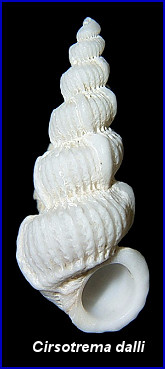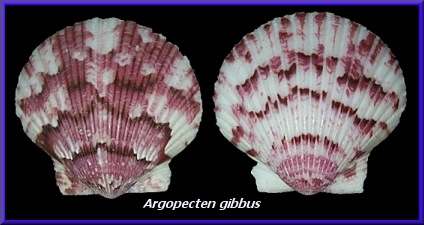|
The Calico Scallop Fishery; Then And Now |
 As recently as 1985, a commercial fishery for the Atlantic Calico Scallop (Argopecten gibbus (Linnaeus, 1758)) flourished off the coast of Northeast Florida. A welcome benefit of this fishery was the ready access to the spoil (and deep water shells) for the members of the Jacksonville Shell Club (JSC). Such coveted collectors' items such as Niso hendersoni Bartsch, 1953 and Cirsotrema dalli Rehder, 1945, among others, were occasionally found in the dump sites at present day Camp Alimacani and adjacent areas around Xalyis Island. To this day, many scallop shells remain just north of the AlA Bridge and an occasional deep water shell can still be found. Unfortunately for JSC dump enthusiasts, this N.E. Florida fishery appears to be gone forever and a study published in 1993 indicates that the entire east coast Calico Scallop fishery is in jeopardy.
In December of 1988 fisherman began to report finding increased numbers of dead and dying scallops. By early January, 1989 there was evidence of widespread mortality. By the end of January, 1989 the population had decreased to the point that no scallops could be found by either commercial or research trawlers. By the summer of 1989 the population had rebounded sufficiently for regular monthly sampling of the population to resume. Population levels became large enough for commercial fishing to resume by the beginning of 1990. There was no evidence of any further problems until January, 1991 when mortality was again observed throughout the Calico Scallop population. By the end of February, 1991 the scallop population had once again been reduced to minimal levels and commercial fishing was suspended. As of September, 1992 the population of Calico Scallops, while increasing, had not reached levels sufficient to enable the resumption of commercial fishing for this species in the Cape Canaveral area. Histopathological examination of the scallops involved in the mass mortality inplicates an Ascetosporan (protozoan parasite) of the genus Marteilia as the primary cause. This is the first reported occurrence of Marteilia in North American waters as well as the first reported instance of a member of the family Pectinidae serving as a host for this genus of Ascetosporans. All histopathological evidence suggests that it was not present in Calico Scallops off Cape Canaveral prior to 1988. This suggests that it is a newly-arrived species, but the mode of transport is unknown. As there is considerable freighter traffic from all over the world using ports on Florida's east coast including Cape Canaveral, it is conceivable that bilge waters from some of these freighters could have transported the protozoan into the area. While this is an easy speculation to make, it is virtually impossible to either prove or disprove. It is also unknown if this parasite has infected other molluscan species of the western Atlantic or what other species from this area may serve as hosts.* Ever wonder how scallops are harvested offshore? Gail Motes and sister-in-law Charlotte Lloyd were fortunate enough to be able to make such a trip during late 1984. An abridged version of her report on this outing entitled "In Pursuit Of The Scallops" follows.** My brother Vic Lloyd is a commercial fisherman operating from Jacksonville and he arranged for us to make a trip one of the scallop boats working out of Mayport.
Beside Charlotte and me, on board were the captain and three crew members. The crew members took wheel watches, keeping an eye out for trouble and monitoring equipment during the 10 hour run to the scallop beds. The crew shared two bunks and the captain had a separate stateroom. Charlotte and I shared the crew's bunk beds. Let me clarify that! Charlotte and I shared one bunk and the crew had use of the other. Since they alternated sleeping times, we never knew who our cabin mate would be at any given time. We left the dock on Sunday afternoon around 3:00 PM and returned on Monday at approximately 4:00 PM. In between there was a mixture of boredom, excitement, sleeping and eating. Vic told me that the scallop boats were converted shrimpers and were not designed for the heavy loads on their decks. As a result, many of them have flipped over in heavy seas. And since we were going out in rough weather, he would call on the marine radio occasionally to check on us. So as I lay in the bunk, I kept thinking that the next wave would be "the wave," the one that would flip us over like a pancake. It added some excitement that I could have done without. On the long trip to the scallop beds, we watched TV, played cards, slept and ate, slept and ate, and ate. For the week, over two hundred dollars worth of groceries were purchased which we helped stow away. Because of the hard work, the cook prepared nourishing meals. Our dinner was roast beef with all the trimmings. Once we reached the scallop beds, the action went from slow motion to fast forward. Two huge nets were lowered over the side and then dragged along the bottom. The captain carefully monitored the time and the net weight and then selected the right moment to bring up the nets. The full nets were hoisted over the deck of the boat. Two men then took hold of the ropes attached to the net ends, pulled, and released the scallops, which rained down on the deck like colored hail. The nets were then returned to the water to resume trawling. During each subsequent trawl, the men spread the shells out on the deck to make room for the next haul. This was not as simple or as easy as it sounds. It is extremely dangerous work. The heavy net can knock a crewman overboard, or when the scallops are piled high on the deck, he can slip and slide right off the boat, especially if the seas are rough and the boat is rolling. Twice we almost had a "man overboard," which would mean he would be lost. In the darkness and rough seas, the chances of finding a crew member swept overboard would be almost non-existent. There was very little time to sort through the shells while we were trawling. The nets were dumped approximately every six minutes. Between hauls there was a lot of activity, and we were kept very busy just staying out of the way, trying to watch the operation, and not make pests of ourselves. There were moments of comedy as we watched the guys in their vinyl coveralls and boots sliding down mountains of scallops trying to keep their balance and navigate from one side of the boat to the other. Quite often they would have scallops or crabs holding on the cuffs of their overalls. There was a lot of beauty too. The night sky was wonderful to watch and enjoy. One of the highlights of the trip was watching the porpoises feeding on the flying fish that the boat was flushing from the water around us. After about three hours of trawling, we were ready to head in to unload. One of our nets had been damaged in the wheel (propeller). Back at the docks we watched the process of unloading scallops into trucks. They were lifted off the boat by a crane and dropped into an open metal funnel. They then traveled along a conveyer belt, separated from the trash (other shells, fish, cabs, etc.) and into waiting trucks. We were finally able to do some serious collecting. Charlotte took one side of the conveyor belt and I took the other. We really did well - nothing exceptional, but large quantities of common shells. We collected tulips, whelks, cones, olives, moon snails, baby's ears, small helmets, paper figs, and others. For me the shell of the trip was beautiful black olive (Oliva fulgurator (Röding, 1798)) in perfect condition. We were given a lot of consideration by everyone involved with the trip both on board and at the dock. They were all polite and helpful. It was a very interesting experience, and I'm glad I had the opportunity to do it. However I would not recommend it for collecting. It is best to stick to the dumps, and if you can ever make a connection, get on one of the conveyor belts. Remember, whether at the dump or on a conveyor belt, always be polite and courteous so that shellers will always be welcomed. *Text paragraphs 3-6 excerpted from "An Acetosporan Disease Causing Mass Mortality In The Atlantic Calico Scallop, Argopecten gibbus (Linnaeus, 1758)" by Moyer, Blake, and Arnold; originally published in the Journal of Shellfish Research 12(2): 305-310, 1993. **Originally published in the Shell-O-Gram 26(1); January-February, 1985. |
 The Atlantic Calico
Scallop was identified as a potential commercial species in the
early 1960's, but large scale fishing off Cape Canaveral did not
begin until the introduction of mechanical processing in 1980.
Production levels have fluctuated greatly since that time, but,
by the 1980's, between 10 and 40 million pounds of adductor meats
were processed annually from the 2500 square miles of fishing
grounds located off Cape Canaveral. During this period, 5
processing plants each supported from 5 to more than 20 boats.
Each scallop boat typically made trips of 16 to 20 hours, 5 to 7
times per week.
The Atlantic Calico
Scallop was identified as a potential commercial species in the
early 1960's, but large scale fishing off Cape Canaveral did not
begin until the introduction of mechanical processing in 1980.
Production levels have fluctuated greatly since that time, but,
by the 1980's, between 10 and 40 million pounds of adductor meats
were processed annually from the 2500 square miles of fishing
grounds located off Cape Canaveral. During this period, 5
processing plants each supported from 5 to more than 20 boats.
Each scallop boat typically made trips of 16 to 20 hours, 5 to 7
times per week. Most of the boats are
working boats with minimum luxuries, but not the one we went on!
The Scott-Gregg came equipped with two color TV's, frost-free
refrigerator with ice maker, a full size gas range, and a head
with a full-size shower and the hottest water ever. Also, the
entire cabin area was air-conditioned. Now that's my idea of
rouging it in style! The electronic equipment on the boat was
fantastic. There were monitoring devices of all types, depth
finders, radios, LORAN, a fish scope that showed the scallops on
the bottom (in color), etc. It looked like the inside of the
space shuttle.
Most of the boats are
working boats with minimum luxuries, but not the one we went on!
The Scott-Gregg came equipped with two color TV's, frost-free
refrigerator with ice maker, a full size gas range, and a head
with a full-size shower and the hottest water ever. Also, the
entire cabin area was air-conditioned. Now that's my idea of
rouging it in style! The electronic equipment on the boat was
fantastic. There were monitoring devices of all types, depth
finders, radios, LORAN, a fish scope that showed the scallops on
the bottom (in color), etc. It looked like the inside of the
space shuttle.